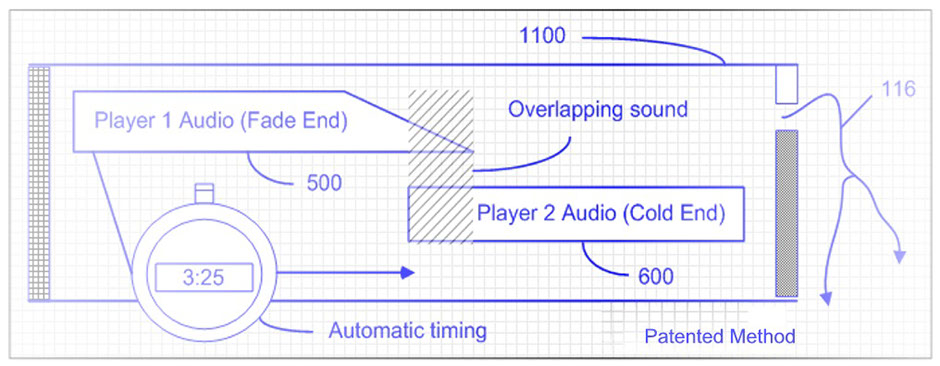Bring Natural Overlapped Music-Flow To Spotify® Streaming Platforms And Applications
Gain a distinctive competitive advantage
Spotify Is Not Without Formidable Competition
In 2019, Spotify® claims about 232 million active users—with about 40% (or 100 million) paid users, and as such, is the current world-leader in active streaming music users. However, as of 2018 Apple® was the leading U.S. streaming music service; followed by Spotify, and Pandora® Media. As of mid 2018, Pandora was estimated to have approximately 78 million active users—worldwide. And other streaming services are growing their free access and paid users every month. So, the streaming sector is highly competitive.
For Spotify, the name of the game is likely innovation. To innovate by offering more value in multiple areas; and perhaps, like its competitors, to improve their listener experience. So, how best to do that? Every other service is also aiming to raise satisfaction with the listener experience. Feature-set competition includes tweaking the UI, the audio bit-rate, search and station modeling, etc.
Claiming Leadership In The Listener Experience Metric
Music applications designed for Web-music players and their desktop-counterpart streaming apps generally suffer from one or two unpleasant song-to-song mixing effects: undesirable SILENCE GAPS or sloppy CROSS FADES. And Spotify, while excelling in many areas of streamed-music presentation, has not yet deployed an effective system to counter the negative effects of SILENCE GAPS and poorly executed CROSS FADES.
In In testing concluded on August 7, 2016 (and again on September 10, 2019), Codentity has confirmed that Spotify's cross fade methods do not consistently deliver smooth, natural song-to-song transitions. (But Codentity's patented methods could help Spotify engineers improve their music-flow experience.)
By contrast, patented Codentity Transition Technology (CTT), if licensed and adapted for streaming networks or applications, could eliminate SILENCE GAPS, and also the necessity for methodology that simulates imprecise and sloppy CROSS FADE transitions. With CTT adapted to execute automatic mixing mode functions, the Web-streamed music-flow experience can be transformed from persistent SILENCE GAP effects and sloppy CROSS FADE style events—to uniformly smooth and naturally-overlapped song-to-song transitions (which is the way the LISTENER expects to hear their favorite music).

The Challenge
Most Streaming Web-Music service presents sequenced song selections in one of two less than optimized states: with disruptive SILENCE GAPS between songs, or with simulated CROSS FADE blending that produces undesirable results.
For song-to-song audio presentations, all known devices present streamed or sequentially played songs as isolated audio events, one song at a time with a 5 to 8 second SILENCE GAP between each song.

In-Car Audio
Even worse, some leading vendors offer automatic music transitions implemented with so-called ‘cross fade’ effects. This technique typically presents Song A with a premature FADE OUT, followed by Song B with an undesirable FADE IN.

Web-Streamers
Watch a short video comparing automatic Codentity Transition Technology vs. Spotify streaming transitions.
Is it possible to innovate, to jump ahead of the pack? Yes. Read the Solution.
The Solution
My company, Codentity® LLC, has patented a system and method for AUTOMATICALLY eliminating the serial SILENCE GAP, and replacing it with smooth, natural, overlapped transitions—AUTOMATICALLY, and in real-time without user actions or file preparations. Or, for songs that end abruptly, Codentity Transition Technology tightly adjoins the start of Song B with the end of Song A—just like a real DJ would.


Patented Codentity Transition Technology (CTT) produces a more appealing listener experience because it is less disruptive, and it presents the music the way both terrestrial and satellite radio do—most importantly, the way the recording artist intended and the way the user expects to hear their favorite music.
The Spotify® Benefit
If a much-improved listener experience were offered for Spotify Web-streams, a distinctive feature advantage could be claimed by the marketing team. An evolutionary advantage to be sure, but nevertheless an advantage that could not be readily duplicated by competitors.
And since even evolutionary enhancements can drive interest, this appealing music-flow feature might bring more users onto the PAID SUBSCRIPTION side of the ledger.
Licensing
Codentity Transition Technology (CTT) is a system and method of automatically refining sequential song-to-song transitions on digital playback devices. CTT eliminates the technical problems heard in almost all other automatic music mixing solutions. For a fee, patented (U.S. 9,286,942) Codentity Transition Technology can be licensed and adapted to create a more natural music-flow experience across a diverse set of digital presentation platforms including:
- Mobile devices (such as smartphones, tablets and in-car audio players)
- Streamed Web-music services (like Spotify®, Pandora®, and many others)
- On-Demand Voice-Command streams (such as interactive services from Amazon®)
- Enterprise music servers (whether satellite or Intranet originated)
- Mobile DJ software (replacing unsatisfactory ‘cross fade’ methods)
License agreements are offered at three levels:
- Platform License (Articulated as single platform or multi-platform)
- Developer Assets Package (Sample source code, programming object maps, step-by-step process execution templates, etc.)
- Developer Consultation Services (Process assistance adapting technology to proprietary music-flow networks)
A condensed technical explanation of Codentity Transition Technology is offered below. I invite interested parties who wish to learn more to contact me directly at 630-487-0934 -- or -- thp8929@gmail.com.
Technical and Practical Benefits Gained from Licensing Codentity Transition Technology
Learn More
©2023 CODENTITY LLC